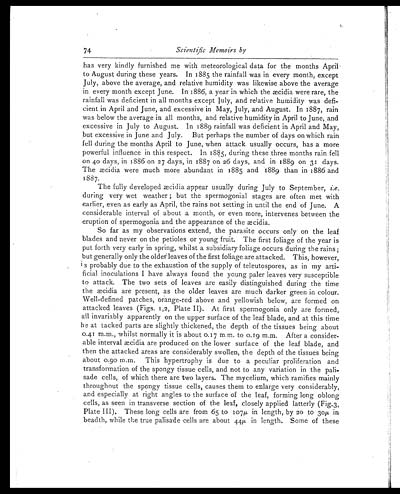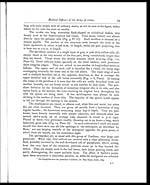Medicine - Institutions > Army health reports and medical documents > Scientific memoirs by medical officers of the Army of India > Part V, 1890 > 4 - On the life-history of a Himalayan Gymnosporangium (G. Cunninghamianum, Nov. Sp.)
(84) Page 74
Download files
Individual page:
Thumbnail gallery: Grid view | List view

74
Scientific Memoirs by
has very kindly furnished me with meteorological data for the months April
to August during these years. In 1885 the rainfall was in every month, except
July, above the average, and relative humidity was likewise above the average
in every month except June. In 1886, a year in which the æcidia were rare, the
rainfall was deficient in all months except July, and relative humidity was defi-
cient in April and June, and excessive in May, July, and August. In 1887, rain
was below the average in all months, and relative humidity in April to June, and
excessive in July to August. In 1889 rainfall was deficient in April and May,
but excessive in June and July. But perhaps the number of days on which rain
fell during the months April to June, when attack usually occurs, has a more
powerful influence in this respect. In 1885, during these three months rain fell
on 40 days, in 1886 on 27 days, in 1887 on 26 days, and in 1889 on 31 days.
The æcidia were much more abundant in 1885 and 1889 than in 1886 and
1887.
The fully developed æcidia appear usually during July to September, i.e.
during very wet weather; but the spermogonial stages are often met with
earlier, even as early as April, the rains not setting in until the end of June. A
considerable interval of about a month, or even more, intervenes between the
eruption of spermogonia and the appearance of the æcidia.
So far as my observations extend, the parasite occurs only on the leaf
blades and never on the petioles or young fruit. The first foliage of the year is
put forth very early in spring, whilst a subsidiary foliage occurs during the rains
but generally only the older leaves of the first foliage are attacked. This, however,
is probably due to the exhaustion of the supply of teleutospores, as in my arti-
ficial inoculations I have always found the young paler leaves very susceptible
to attack. The two sets of leaves are easily distinguished during the time
the æcidia are present, as the older leaves are much darker green in colour.
Well-defined patches, orange-red above and yellowish below, are formed on
attacked leaves (Figs. 1,2, Plate II). At first spermogonia only are formed,
all invariably apparently on the upper surface of the leaf blade, and at this time
he at tacked parts are slightly thickened, the depth of the tissues being about
0.41 m.m., whilst normally it is about 0.17 m.m. to 0.19 m.m. After a consider-
able interval æcidia are produced on the lower surface of the leaf blade, and
then the attacked areas are considerably swollen, the depth of the tissues being
about 0.90 m.m. This hypertrophy is due to a peculiar proliferation and
transformation of the spongy tissue cells, and not to any variation in the pali-
sade cells, of which there are two layers. The mycelium, which ramifies mainly
throughout the spongy tissue cells, causes them to enlarge very considerably,
and especially at right angles to the surface of the leaf, forming long oblong
cells, as seen in transverse section of the leaf, closely applied latterly (Fig.3,
Plate III). These long cells are from 65 to 107µ in length, by 20 to 30µ in
beadth, while the true palisade cells are about 44µ in length. Some of these
Set display mode to: Large image | Zoom image | Transcription
Images and transcriptions on this page, including medium image downloads, may be used under the Creative Commons Attribution 4.0 International Licence unless otherwise stated. ![]()
| Permanent URL | https://digital.nls.uk/75000500 |
|---|
| Shelfmark | IP/QB.10 |
|---|---|
| Additional NLS resources: | |




